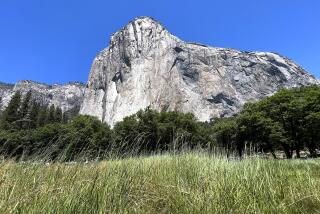These Old Parks Must Struggle to Keep Up With Wear and Tear
- Share via
MT. RAINIER NATIONAL PARK, Wash. — Supt. Dave Uberuaga compares the upkeep of Mt. Rainier National Park to that of maintaining a beautiful old home -- with 2 million visitors a year.
As he walks along the lush green trail to the Ohanapecosh campground from Silver Falls, Uberuaga’s lament is familiar to anyone who has ever owned a house, especially an old one, that is loaded with character and an endless supply of things that break, wear out or need updating.
“Everything seems to cost more than it should,” he said. “The materials cost more. The craftspeople cost more.”
Established in 1899, Mt. Rainier in the Washington Cascades is the fifth-oldest national park. It still looks much as it did in the 1930s and has been designated a National Historic Landmark District.
But it has a documented backlog of about $101 million in work that needs to be done, about half of which is road repair and upgrades -- part of a $4.9-billion backlog of maintenance projects identified at National Park Service sites throughout the country.
The Bush administration and Congress have been criticized by groups such as the National Parks Conservation Assn. in recent months for failing to budget sufficient money to properly staff, run and care for some of the country’s treasured national parks, monuments and historic sites.
“The national park system is an amazing thing the American people gave to themselves,” said John Titland of Bellevue, a past president of Mt. Rainier National Park Associates, a friends of the park group.
“Now we’re at a point where the political administrations don’t see it as a benefit. They see it as a liability that they just have to pay for.”
The administration has made significant strides in bringing computer efficiency to inventorying National Park Service assets, and identifying and prioritizing the work that needs to be done to keep them in good shape, said Donald Murphy, deputy director of national parks.
The improvements being made are not particularly glamorous or even always noticeable, but they’re important, he said.
At Yellowstone National Park a wastewater treatment plant and a sewer line had to be redone because they posed an environmental threat to Old Faithful, he said.
At the Federal Hall National Memorial in Manhattan, cracked walls and the foundation needed work. Cedar Hill, the home at the Frederick Douglass National Historic Site in Washington, D.C., needed a new climate control system to protect books in its library.
At Rocky Mountain National Park in Colorado, visitors complained about stinking toilets.
“We replaced all the bathrooms and they don’t smell anymore. Those kind of things impacted visitor enjoyment,” Murphy said. “All of these are unglamorous things.”
In the last two years, the federal government has made $2.9 billion available to address the backlog, which is targeted for elimination over five years, he said.
“I really think we’re doing the right thing in parks right now with the goals and priorities that we have,” Murphy said.
“Our No. 1 goal is making sure the resources we have are very well taken care of.”
Mt. Rainier National Park, home to the 14,410-foot volcano of the same name, has some special maintenance challenges in addition to the historic preservation of its rustic infrastructure.
“The climate is very severe,” said Dan Blackwell, chief of maintenance for the park. “I don’t think a lot of people know what 40 feet of snow on the ground looks like. In the winter, that’s what I’ve got up at Paradise. Our construction season is very short.”
Rehabilitating the 85-year-old Paradise Inn is one of the projects being funded, with more than $13 million for foundation work.
Mt. Rainier National Park has an annual budget of $3.1 million for operations and preventive maintenance, about 75% of which goes to activities such as cleaning restrooms, plowing snow, and operating water and wastewater systems.
“Where we have a problem are the operational dollars. They are what’s eroding and eroding fast,” Blackwell said.
Most of the park’s regular maintenance money is spent on operations, so preventive maintenance gets the short end of the stick. There has not been a tangible increase in six years, he said.
“We are not spending enough money on preventive maintenance -- period,” he said. “That’s why the backlog curve seems to be static.”
How much is apparent to the visiting public is unclear. If the roads are drivable, the trails negotiable and the restrooms clean, most people probably don’t notice the deterioration.
“I think if you went to the park and looked at some of the older buildings, you would be surprised how many of them are rotting and falling apart,” said Titland, who has been a volunteer at the park for the last decade.
“They just don’t have the maintenance budget to keep them going.”
In the backcountry -- 97% of the park is wilderness -- there are at least a couple of cabins in such bad condition that no one wants to use them, he said.
Under the priority system, parks compete for some maintenance dollars, based on the importance of the asset, and health and safety considerations.
“The need out there is significant and even the lowest priority is compelling,” Uberuaga said.
More to Read
Sign up for The Wild
We’ll help you find the best places to hike, bike and run, as well as the perfect silent spots for meditation and yoga.
You may occasionally receive promotional content from the Los Angeles Times.






